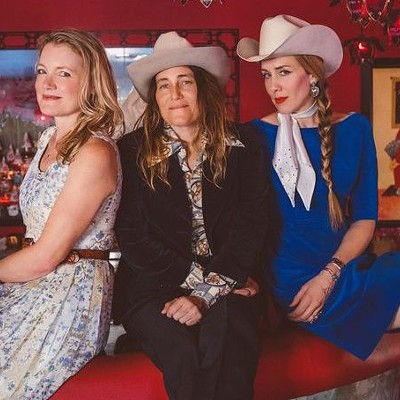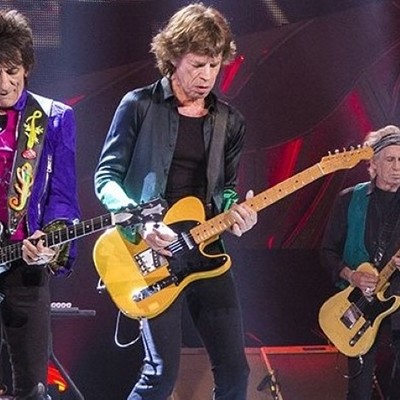But in 1973, the Stooges were crap. Really. Beset by poor record sales, chaotic concerts, general revulsion by most music listeners, and drug problems, they blew
That assessment is just one of the reasons that Gimme Danger is one of the best rock documentaries in what has become a contemporary golden era for the
And largely on the shoulders of a front man who is not only one of
A life — as he tells Jarmusch’s cameras — trying to one-up the
"Being that Iggy approached us to make the film, I didn’t necessarily expect him to be as hands-off as he was," says producer Carter Logan. "But Jim Osterberg’s idea was to choose Jim Jarmusch and let him go with it. This was a gracious act of trust coming from a true gentleman. It was very deliberate and diplomatic. And that’s who Jim Osterberg is. Iggy Pop might dive onto your head, but Jim Osterberg is on a beach somewhere right now reading Alexis de Tocqueville."
Fun facts that Gimme Danger tells us about Mssr. Pop:
* His consistent and constant preference for giving bare-chested performances
* His inspiration as a musical lyricist was TV comedian Soupy Sales, who asked his young viewers to send in letters of only 25 words or less. Pop says, “I didn’t feel like I was Bob Dylan.”
* He pretty much invented the stage-dive. But upon his first try at the stunt, the two “large women” in the audience he thought would catch or cushion him split when he took flight. The resulting thud on the bare floor left him with two fewer front teeth — one of them embedded in his lip.
*When a conscientious Ron Asheton called up Moe Howard to ask if it was okay for the band to be called The Stooges, the bowl-
Of course, while Iggy is the film’s focal point and gets the most face time, Jarmusch (who has also cast Pop as an actor in several of his movies) is sure to make certain the rest of the band is represented as well. Guitarist/bassist Ron Asheton, who died in 2009, is seen in archival footage.
His brother, drummer Scott Asheton, who died in 2015; guitarist James Williamson; and part-time sax man Steve MacKay (who died in 2015) offer reflections in contemporary interviews. Asheton sister Kathy, Stooges early champion/manager Danny
Unfortunately, there seems to be no existing interview footage of original bassist Dave Alexander, who died in 1975 at age 27 as a result of his incessant drinking.
Gimme Danger also has segments of animation, mostly illustrating bizarre and hilarious tales — including one in which an ignorant Pop bought a marijuana plant with dirty roots intact and tried to cure it in a clothes dryer — and use of movie/TV/stock footage.
"For us the aim from the start was to make a film that would pay tribute to this incredible band, telling the story in their own words, illustrated in a visual style which represents their music as best we could. Iggy speaks about the countless forms of music that influenced them, but we also learned that band, in
"The fantastic animation by James Kerr reflected this as well. In his work, James used elements of very old classical painting, tore those apart, and reconfigured the detritus into the Stooges world," the producer adds. "It’s
But it’s the live footage of the band during its late-’60s/early ‘70s heyday that is revelatory, and all the more reason to see this film in a real theater with a kick-ass sound system. It also shows you how genuinely unhinged and unpredictable a Stooges show could be: a barely contained riot that just happened to feature howling vocals and heavy instruments. And maybe Ron Asheton would flash a piece of the genuine Nazi memorabilia he liked to collect as a way to bond with his U.S. veteran father.
Iggy and the Stooges released only three albums between 1968 and 1973: The Stooges, Fun House and Raw Power. But one could argue that no troika of records made a bigger impact on future musicians. The members of the Ramones bonded as teens largely because they were the only four people they knew who liked the Stooges. And the film includes a montage of acts like Black Flag, the Dead Boys, the Cramps, the Damned, the Sex Pistols and — yes — the Ramones performing Stooges covers.
"When I think about the Stooges in musical terms, what sets them apart to me is their synthesis of power and fluidity. They are volcanic — there’s an eruption from the front man at the top, but the real force is in the molten magma flow from the guitars and seismic aftershocks of percussion," Logan sums up.
"In historical
Gimme Danger will screen at 7 p.m. December 2 and 9; 6 and 8 p.m. Saturday, December 10; and 5 p.m. Sunday, December 11 in the Brown Auditorium at the Museum of Fine Arts, Houston (1001 Bissonnet). See mfah.org/film for details. $7-$9.






